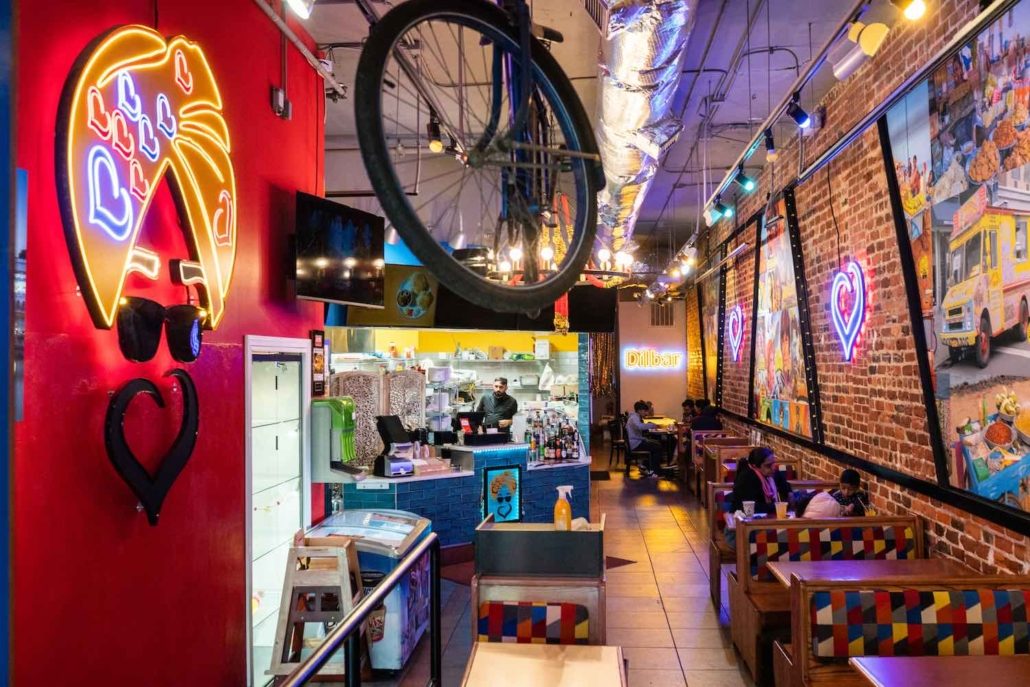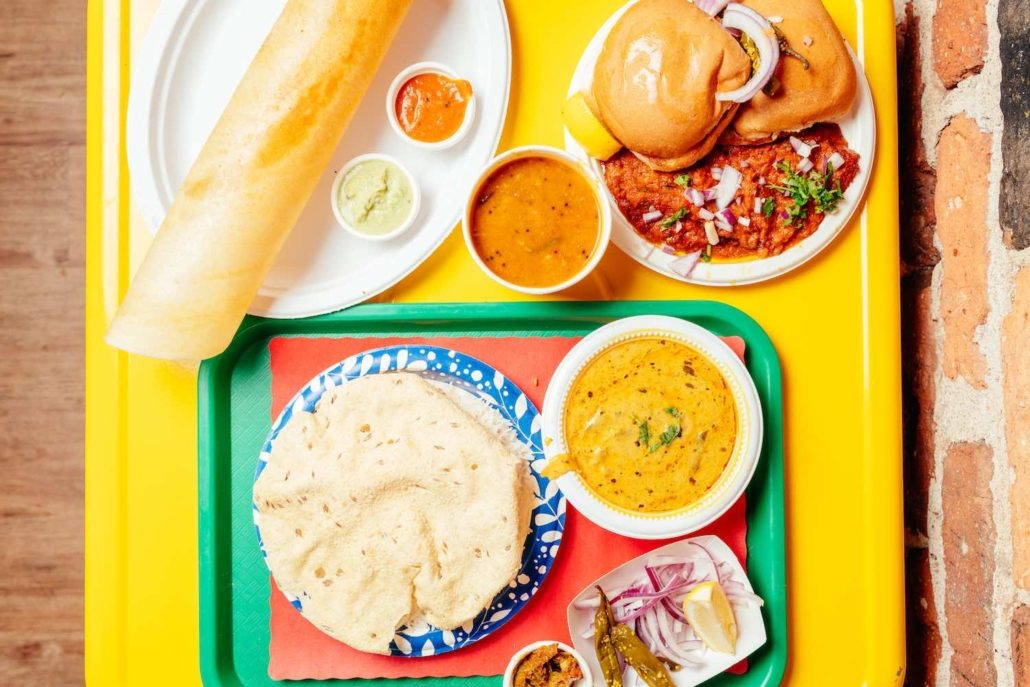GLOBAL APPALACHIA
Why Indian street food is attracting a foodie following
BY TENNILLE T LEGLER | PHOTOS BY ANDY LUKACS-ORMOND
***
The chefs work in quick movements, spreading batter over a hot griddle and manipulating a spatula around a sizzling mound of vegetables. Their fingers dip into containers of turmeric and chili powder, cumin and coriander, adding a colorful pop of flavor on a plate.
Outside in the dining room, a sensory delight. Crowds of people standing and laughing alongside a row of tables with multi-colored cushions, a jangle of music pouring from the speakers of a wall-mounted TV and a Bollywood movie with dancers. The warm smell of spices throughout.
This is the scene inside Dilbar, one of Asheville’s popular Indian street food restaurants, a downtown hot spot that attracts a steady stream of both tourists and locals and, perhaps more notably, Indian families from Charlotte, Raleigh and Atlanta willing to make the trek for the sounds and smells of home.
“Dilbar is meant to feel like the streets of India,” says owner Al Singh. “There’s all of this chaos, but really that’s the best part.”

When it comes to Indian food in the U.S., Americans have quickly embraced the now-familiar cuisines of North India—dishes like tandoori chicken and butter chicken, served with rice or naan—and these are what often appear on the stateside menus. But the broad category of eats known as “street food” is the more familiar fare for millions of Indians. Affordable and easy to eat, usually served outdoors from stalls or carts, street food is a cultural phenomena unto itself.
An appetite for Indian street food has hit Asheville hard. It started in 2009, when chef Meherwan Irani opened his now-famous Chai Pani eatery, introducing many locals to chaat, a collection of savory snack dishes that Irani once described as the more “democratic” and “egalitarian” version of Indian cuisine.
Among the favorites on the Chai Pani menu is uttapam, a crepe made with a batter of rice and lentils and offered with a variety of toppings; and behl puri, a tangy and crunchy street food classic made with puffed rice, crunchy chickpea noodles, flour crisps, cilantro and onions. There’s also the crowd-pleasing vada pav, potato dumplings fried in curried chickpea batter, served on a bun with green and tamarind chutneys.
Irani has since opened a second Chai Pani location in Decatur, Georgia, as well as a string of restaurants called Botiwalla, paying homage to India’s “Irani cafés” and their beloved snack dishes, as well as the country’s late-night street food scene. In 2022, Chai Pani received a coveted James Beard Award for “Outstanding Restaurant,” just one year after being named one of “America’s Favorite Restaurants” by The New York Times, catapulting the small eatery into a destination for food lovers around the country.
Dilbar is a more recent addition to Asheville’s Indian street food scene—recently declared one of the hottest new restaurants in Asheville—and has quickly attracted its own loyal fan base. It offers a variety of dosas (thin crepes made from a fermented batter of lentils and rice, served with different toppings and chutneys) as well as the crowd-pleasing frankies, hailing from Mumbai, which are wholewheat rotis stuffed with vegetables, paneer, lamb or chicken. The pav bhaji is a delightfully flavorful vegetable curry cooked in a tomato gravy and served with a bread roll. And for all of you bread fans, the chole bhature is a dish of the most perfectly fried fluffy flatbread, served with a chickpea curry.
“The best street food is served in Old Delhi, where you have these narrow alleys and food carts lined along the side of the street,” Singh says. “I remember standing in lines for chole bhature and the vendors would serve it on a paper plate with chutney and a piece of pickle. I’ve never had this done right in any upscale restaurant.”

Born in Delhi and raised in the northern state of Punjab, Singh lived in several Indian cities as a result of his parents’ appointments in the Indian army. After arriving in Asheville in 2014, by way of California and New York, he purchased a portfolio of Citistop stations and then moved into the restaurant business in 2021 with the launch of the Indian fine-dining restaurant Andaaz in Biltmore Village. He then quickly moved his business ambitions into Asheville’s downtown with the opening of Dilbar and its neighbor, Mehfil, which offers the popular dishes of North India.
Indian street food is just as varied as the country from which it hails, a sprawling land of 1.4 billion people. It’s been said that, in India, the language, culture and food change about once every 100 miles or so. But much like the street food in other countries—think pizza, hot dogs, gyros and tacos in the U.S.—the unifying theme is the food’s approachability and widespread appeal, but with the signature flavors that distinguish Indian food and attract a global following.
Asheville doesn’t have a particularly large Indian community; rather, the proliferation of Indian eateries is owed to Irani and Singh, and a few other pioneering Indian entrepreneurs who seek to bring the food of their youth to one of the culinary hotbeds of the South.
To be sure, many Indians link street food with cherished memories—the charming experiences of childhood or time with family and friends. “I remember the pani puri man in my neighborhood as a kid,” Singh says, referring to the crispy-fried, hollow dough balls,filled with both savory and sweet flavors, and sold on residential streets much like the ice cream truck in the U.S. “The kids would all come around the cart and the man would just drop the treats in your hand, one at a time, and we’d pop them in our mouth—now five, now 10. And the whole time, the pani puri man is keeping track of how many each kid has had.”
Like all cuisines, which can change and evolve over time, some of the Indian street food dishes have been tweaked to appeal to the palates of folks living in the American South, while others maintain a strict adherence to traditional techniques and flavors. Either way, the end goal is to capture the relaxed experience of “real” food from India, Singh says, because “street food is about going out and having a good time.”
Save
Save
Save
Save
Save
Save
Save
Save
Save
Save

A trio of signature desserts from Dilbar
THE WEEKLY REVEL
Sign up for your free handpicked guide to enjoying life around Asheville.
Available weekly from May to October.





